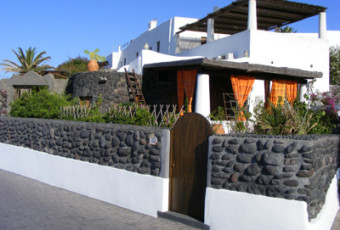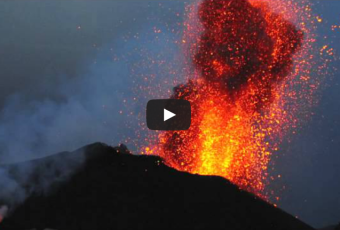What to see at Stromboli
Once arrived at Scari , where the port is located, you immediately 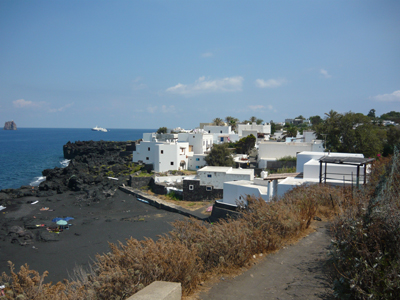 notice the charm of this island surrounded by the colors and flavors unique to this high cliffs broken by small jet-black sand beaches and caves, the white Mediterranean houses, the green palm trees, olive trees, citrus trees resting upon a harsh but fascinating volcanic cone in a sea of intense blue.
notice the charm of this island surrounded by the colors and flavors unique to this high cliffs broken by small jet-black sand beaches and caves, the white Mediterranean houses, the green palm trees, olive trees, citrus trees resting upon a harsh but fascinating volcanic cone in a sea of intense blue.
Leaving the port there is a road that leads directly into the town, this steep slope plunges into the green prickly pears, the caper plants, the colorful geraniums and bougainvilleas and typical shops where you can taste local delicacies, all that will accompany you until you get to Piazza San Vincenzo from which the Church takes its name. Facing the square there is the view out of the harbor and the beach of Scaria and the Strombolicchio, the oldest volcano of the Aoelian islands which stands like a fortress on the sea. From this square a horizontal climb leads to top of Stromboli, a path up to level 450 is very simple passing the traffic light 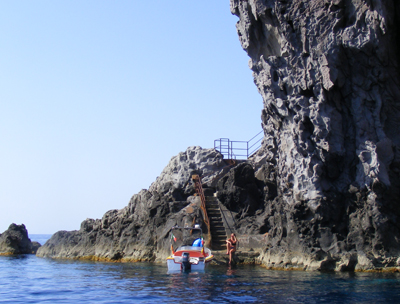 in San Vincenzo up to 195 Prima Rina , all lined with vegetation consisting mainly of shrubs. The next section called Liscone is more challenging, the passage becomes rocky landslide, so you should have a guide accompany you, The effort for the two-hour walk will be repaid at some point when you are in a lunar landscape with craters where the continuous eruptions dominate the landscape. The trail continues up to the summit of Stromboli, following the path up to Pizzo and onward to Vancori.The landscape that promises to remain imprinted in your memory, you will be hanging over Ginostra, and on days with good visibility you can see the coast of Sicily, Mount Etna, the Strait of Messina and the Calabrian coast to Scalea.
in San Vincenzo up to 195 Prima Rina , all lined with vegetation consisting mainly of shrubs. The next section called Liscone is more challenging, the passage becomes rocky landslide, so you should have a guide accompany you, The effort for the two-hour walk will be repaid at some point when you are in a lunar landscape with craters where the continuous eruptions dominate the landscape. The trail continues up to the summit of Stromboli, following the path up to Pizzo and onward to Vancori.The landscape that promises to remain imprinted in your memory, you will be hanging over Ginostra, and on days with good visibility you can see the coast of Sicily, Mount Etna, the Strait of Messina and the Calabrian coast to Scalea.
Returning to the church of San Vincenzo along Via Vittorio Emanuele, you’ll be right in front of the house where Ingrid Bergman and Roberto Rossellini, stayed during the filming of Stromboli Land of God in 1949, was their love nest, now remembered by a plaque. The road broken up into smaller roads that lead you to the sea, full of charm, leading to the church of St. Bartholomew, built in 1801, in front there is a statue of the saint .
Continuing from the church you can easily get Piscità, residential area known for its numerous coves and beach nestled bet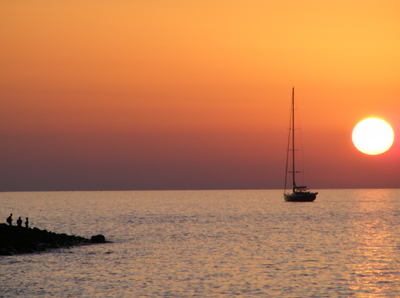 ween the ridges of black lava rock. The road leads up to a wide beach that marks the end of the urban and the beginning of the Sciara del Fuoco. One of the most fascinating experiences is during the sunset, the sun as it descends acquires a reddish color that illuminates the sky and then goes out on the water. At the end of Piscità there is a narrow and dusty but quite rich in Mediterranean vegetation, which leads to the observatory, now a restaurant (find transport with one ofthe classic “apette”), the place is just 100 m from the crater and at night you can comfortably enjoy your dinner while you can see explosion and lapilli, events that are repeated on average every 15/20 min. When travelling at night do not forget to bring a flashlight, the island is not lit and it allows you to see a carpet of stars as if you were out at sea.
ween the ridges of black lava rock. The road leads up to a wide beach that marks the end of the urban and the beginning of the Sciara del Fuoco. One of the most fascinating experiences is during the sunset, the sun as it descends acquires a reddish color that illuminates the sky and then goes out on the water. At the end of Piscità there is a narrow and dusty but quite rich in Mediterranean vegetation, which leads to the observatory, now a restaurant (find transport with one ofthe classic “apette”), the place is just 100 m from the crater and at night you can comfortably enjoy your dinner while you can see explosion and lapilli, events that are repeated on average every 15/20 min. When travelling at night do not forget to bring a flashlight, the island is not lit and it allows you to see a carpet of stars as if you were out at sea.

